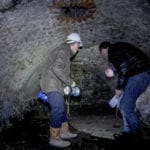 Mysteries
Mysteries  Mysteries
Mysteries  History
History 10 Surprising Stories About the Texas Rangers
 Humans
Humans 10 Philosophers Who Were Driven Mad by Their Own Theories
 Miscellaneous
Miscellaneous 10 Video-Game-Worthy Weapons and Armors from History
 Weird Stuff
Weird Stuff 10 Psychics Who Accurately Predicted Wartime Events
 The Arts
The Arts 10 Pieces of Art Inspired by a Broken Heart
 Health
Health 10 Science Fiction-Sounding New Medical Treatments
 History
History 10 Surprising Facts About the Father of Submarine Warfare
 Space
Space Ten Astonishing New Insights into Alien Worlds
 Weird Stuff
Weird Stuff 10 Bizarre Summer Solstice Rituals Still Practiced Today
 Mysteries
Mysteries Top 10 Haunting Facts About the Ghost Ship MV Alta
 History
History 10 Surprising Stories About the Texas Rangers
 Humans
Humans 10 Philosophers Who Were Driven Mad by Their Own Theories
Who's Behind Listverse?

Jamie Frater
Head Editor
Jamie founded Listverse due to an insatiable desire to share fascinating, obscure, and bizarre facts. He has been a guest speaker on numerous national radio and television stations and is a five time published author.
More About Us Miscellaneous
Miscellaneous 10 Video-Game-Worthy Weapons and Armors from History
 Weird Stuff
Weird Stuff 10 Psychics Who Accurately Predicted Wartime Events
 The Arts
The Arts 10 Pieces of Art Inspired by a Broken Heart
 Health
Health 10 Science Fiction-Sounding New Medical Treatments
 History
History 10 Surprising Facts About the Father of Submarine Warfare
 Space
Space Ten Astonishing New Insights into Alien Worlds
 Weird Stuff
Weird Stuff 10 Bizarre Summer Solstice Rituals Still Practiced Today
Top 10 U.S. Secret Missions That Went Belly Up
Since its beginning, the U.S. has conducted numerous secret missions. The goals of these operations have included rescue, likely espionage, intelligence-gathering, the investigation of vehicles of possible extraterrestrial origin, and the waging of an international “war on drugs.” For various reasons, each of them on this list went belly up.
Related: 10 Things You Won’t Believe Can Spy On You (But Do)
10 Operation Eagle Claw
Like many covert missions, Operation Eagle Claw was assigned a thrilling name. The 1980 operation also had a noble purpose, the rescue of 53 Americans who were being held hostage by 3,000 Iranian militants at the U. S. embassy in Tehran, Iran. The kidnapping was intended to demonstrate the captors’ displeasure at President Jimmy Carter’s allowing the deposed Shah of Iran, Mohammad Reza Shah Pahlavi, to enter the U. S. for medical treatment.
After extended attempts to resolve the situation through diplomatic means failed, Carter approved the rescue mission, a joint military operation. However, things did not go as planned.
A dust storm caused a deadly collision between one of the transport helicopters and a C-130 aircraft. The inability of two other helicopters to continue the flight and the breakdown of a third reduced the number of helicopters to five, one fewer than was needed to conduct the mission. The operation was aborted. “The failed mission, in addition to loss of life, was a humiliating blow for the U.S.,” an Air Force article declared.[1]
9 Zuma
CBS News reporter William Harwood points out that on the morning of January 7, 2018, “a classified [SpaceX] satellite code-named Zuma,” built by Northrop-Grumman, crashed into the Indian Ocean soon after it was launched at Cape Canaveral, Florida, despite its rocket having operated “normally.”
Due to the classified status of the satellite, neither SpaceX nor Northrop-Grumman representatives would divulge any information about the satellite’s payload or the failure of the mission. SpaceX President Gwynne Shotwell would say only that the launch had been conducted correctly and that “the data reviewed… [indicated] no design, operational or other changes [were] needed.”
Quoting anonymous sources, the Wall Street Journal reported that “the secret payload… is believed to have plummeted back into the atmosphere… because it didn’t separate as planned from the upper stage of the rocket.”
Marco Langbroek, a veteran satellite tracker added, “Zuma could have been put into the wrong orbit; the satellite suffered some sort of internal failure after reaching orbit; or Zuma failed to detach from the second stage,” but the reporter also concluded, “the precise sequence of events with the Zuma mission may never be known.”[2]
8 Foley Rescue Mission
Another rescue mission that did not fare well was the secret operation to liberate American journalist James Foley and others being held captive in Syria by Islamic State (IS) militants. President Obama authorized the operation, which Pentagon officials said involved air and ground components. The reason for the failure of the mission was simple: “The hostages were not present at the targeted location.” According to a BBC report on the operation, “several dozen special troops, dropped by aircraft into Syria,” killed a number of IS militants without themselves suffering casualties.
As a result of the mission’s failure, Foley was decapitated. A video showing the start of the beheading cuts away to show its aftermath: Foley’s body, lying on the ground. The video warned, “Any attempt by you, Obama, to deny the Muslims their rights of living in safety under the Islamic caliphate will result in the bloodshed of your people.”
Obama called the killing “an act of violence that shocks the conscience of the entire world” and declared the militants’ ideology bankrupt. The United Nations, the United Kingdom, and others also denounced the horrific act as abhorrent.[3]
7 Weapons of Mass Destruction
President George W. Bush’s decision on whether to conduct military operations against Iraq in 2003 was based on faulty intelligence gathered by the Central Intelligence Agency (CIA). When the CIA indicated that Iraq possessed weapons of mass destruction that could endanger the U. S. and its allies, Bush decided to go to war. As a result, hundreds of thousands of civilian and military casualties were sustained.
On March 31, 2005, the Commission on the Intelligence Capabilities of the United States Regarding Weapons of Mass Destruction declared that the CIA’s intelligence “was dead wrong in almost all of its pre-war judgments about Iraq’s weapons of mass destruction” and recommended a number of corrective measures to prevent such monumental errors in the future.[4]
6 Ghetto Information Program
According to the FBI Charter Act of 1979, S. 1612, the U.S. Federal Bureau of Investigation (FBI) conducted the Ghetto Information Program (GIP), which began in 1963 and lasted until at least 1972. The program’s 7,000 informants, who gathered intelligence inside African-American neighborhoods, was an astonishing number, constituting nearly half of the 15,000-strong army the Bureau used in its domestic intelligence information program.
In fact, 85% of all domestic intelligence cases in 1976 involved the use of informants in the [GIP] alone. As a statement by Senator Howard M. Metzenbaum indicates, “The picture that emerged from [the sources that the Committee examined] is not a pleasant one,” reflecting, as it did, common violations of constitutionally protected rights and other “FBI misdeeds.”
Although the Nation of Islam (NOI) was admittedly not “involved with sporadic violence against police [and]… had been unjustly blamed for violence in the ghetto riots of 1967 and 1968,” the NOI was, nevertheless, targeted because the organization, as a paramilitary-type group, was considered to “represent a potential… force to be reckoned with.”[5]
5 Thin Thread
In a report for the Baltimore Sun, Siobhan Gorman writes that, although the 1990s’ pilot program Thin Thread could analyze massive amounts of telephonic communications more quickly and efficiently than the rival Trailblazer program, the National Security Agency (NSA) ultimately rejected Thin Thread due largely to “bureaucratic infighting.”
Thin Thread was seen as a threat to Trailblazer, the $1.2 billion program favored by the NSA. According to an unnamed member of the intelligence community, Thin Thread would humiliate those who supported Trailblazer because the former would perform better at sifting through phone data than the latter.
Besides, critics maintained, Thin Thread was too aggressive, and its collection of data from domestic communications could violate American citizens’ civil liberties. The debate led to a flip-flop, as those who had initially supported Thin Thread came to back the adoption of Trailblazer instead, despite Trailblazer’s being the inferior surveillance program.[6]
4 Operation CHAOS
During the presidency of Lyndon B. Johnson, the CIA initiated Operation CHAOS to conduct secret domestic surveillance on suspected “American radicals.” Under President Richard Nixon, the program was expanded.
New York Times reporter Seymour Hersh knew that he was onto a major exposé when he discovered that, during Operation CHAOS, the CIA had amassed a mountain of illegal domestic intelligence. Aghast, Senator Frank Church chaired a committee to investigate the charges. Among other disturbing facts, the committee found that Operation CHAOS had resulted in the creation of 7,200 files on American citizens.
Although the massive campaign resulted in no links between “the most prominent peace movement leaders” and U. S. embassies, reaching the conclusion that the indigenous social movements were based on “ideological differences with [President Nixon’s] foreign and domestic policies,” the CIA continued its politically sensitive domestic spying program until 1973, when it was feared, correctly, that the program would be discovered.[7]
3 The Black Chamber
Ironically, the American Black Chamber (aka MI-8) was too successful for its own good. As Glenn P. Hastedt, author of Spies, Wiretaps and Secret Operations, writes, this precursor to the NSA operated out of the second story of a building in New York City. Headed by cryptologist Herbert O. Yardley, it was financed by the Department of State. Although the building’s first-floor tenant, the Code Compilation Company, earned a modest profit by providing cryptographic services to local businesses, it was actually a front for its upstairs neighbor.
The Black Chamber was highly successful at deciphering ciphers and other coded messages until Secretary of State Henry Stimson, shocked to learn of the clandestine organization, shut down the office in 1929. As a result, Yardley wrote The American Black Chamber two years afterward, reasoning, as Hastedt observes, that secrecy regarding the mission was unnecessary now that the Black Chamber had ceased operations. The Japanese purchased numerous copies of Hastedt’s book, leading them to change “all their codes in government and trade.” Other countries followed their lead. A loophole in U. S. espionage laws, since revised, prevented Yardley’s prosecution.[8]
2 Bigfoot
The FBI’s website displays letters, memorandums, newspaper clippings, and photographs regarding its collaboration with Peter Byrne, director of the Bigfoot Information Center and Exhibition in Oregon. In his December 1976 response to Byrne’s November 24, 1976, letter, Jay Cochran, Assistant Director of the FBI’s Scientific and Technical Services Division, agrees to test hairs and tissue that may be those of Bigfoot and invites Byrne to send the specimens to the FBI laboratory in the J. Edgar Hoover Building in Washington, D.C.
In a letter dated September 10, 1976, Cochran advises Byrne that, contrary to Byrne’s statement that the FBI is alleged to have examined hair “supposedly of a Bigfoot,” no “references to such examinations” can be found in FBI files. However, Cochran writes, in a letter to Byrne dated February 24, 1977, that the FBI laboratory did, in fact, conduct a “light microscopy” of Byrne’s specimens, which revealed them to be “hairs are of deer family origin.”
Case closed? It would seem so. As Popular Mechanics wryly points out, FBI “files are released only when a subject is deceased, which not only points to the figure being real, but also suggests that the agency believes it is dead.”[9]
1 War on Drugs
In June 1971, an international “war on drugs” led by the U.S. got underway. It continues today, despite the fact that many judge the global conflict to have failed. Ironically, for a time, as Rhodri Jeffreys-Jones points out in the second edition of Cloak and Dollar: A History of American Secret Intelligence, the CIA was involved in the drug trade. In fact, as a book by Alfred McCoy laid out, “the agency [transported] opium grown by ‘anti-communist’ Laotian tribesmen.”
The agency’s hope of suppressing McCoy’s exposé, like its desire to defend itself against charges of its “longstanding involvement in the world’s prime heroine-producing regions,” was hampered, the author states, by the constraints of national security. Tangled, questionable international relationships made any such defense even more difficult. For example, Jeffreys-Jones observes that in Panama, General Manuel Noriega wasn’t just “on the CIA payroll,” but he also served “the KGB and the notorious Colombian cocaine cartels.”
On the U.S. home front, the war went from bad to worse. Although the Reagan-Bush years showed improvement, with a sharp decline in the number of Americans who were regular users of illicit drugs, the downward trend reversed during the 1990s, Jeffreys-Jones says. More citizens used heroin, and the age of drug users dropped from the “average age… of 26.6 years old in 1990 to 17.6 years old” seven years later.
The answer, President Bill Clinton suggested, might be to set the CIA loose on global drug traffickers. Senator Daniel P. Moynihan didn’t think so, not when “several dozen federal agencies were already addressing the drugs and crime problem, none of them with notable success.” Despite decades of effort by the U. S. and a coalition of other nations, illicit drug use remains an apparently unstoppable juggernaut.[10]








